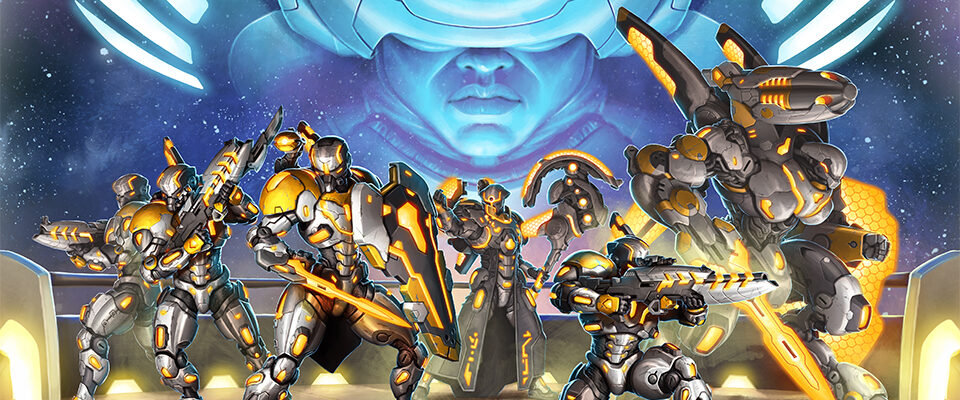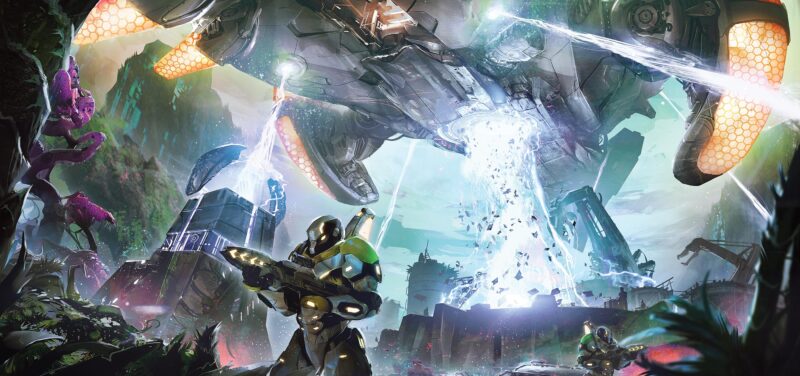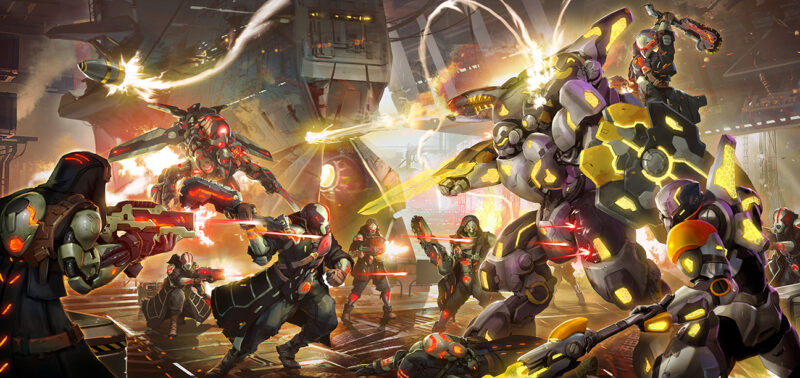by Jason Soles
Having explored the background of the Iron Star Alliance, we can better examine the design decisions and philosophies behind the Faction. Founded with the aspiration of ensuring peace and prosperity for its countless citizens and of bringing together the whole of human civilization under a single banner, the Alliance is a vast and complex empire. Though it possesses great resources and a teeming population, the stability of the empire is a constant concern for its ruling classes and administrative bodies.
The worlds, territories, and settlements of the Alliance are entirely dependent upon the bloc’s networks of void gates in order to remain interconnected and unified. These void gate networks and the trade of resources that flows through them constitute both the true strength of the Alliance and its greatest weakness. Disruptions to these networks can have dire consequences, and the enemies of the Alliance have long exploited these vulnerabilities to slow the growth of the empire and to cause pain to far-flung colonies that rely on goods ferried from distant stars for their very survival. The lack of definitive knowledge of the gates and their seeming unpredictability further jeopardize the security of the bloc.
As a result of military conquests, infrequent rebellions against Alliance rule, and fluctuations in the stability of void gate networks, the borders of the Alliance are in a constant state of flux. And while the Alliance is always seeking to expand, it must also take care to shore up its own internal stability. Putting down rebellions, guarding shipping lanes, and protecting vulnerable void gate networks, natural resources, cities, and outposts all require a huge military presence, which is almost as vital to the stability of the Alliance as the void gates themselves. This is not even to speak of the vast armies required to wage the empire’s wars of expansion across human space.
All told, there are few truer signs of Alliance rule than the ubiquitous presence of the silver-clad Paladin forces and the lumbering war machines that stride beside them in battle. These forces are tasked not only with the safety and security of the Alliance itself but also with the subjugation and conquest of its enemies. The Paladins are believed to constitute the largest fighting force in the Hyperuranion (though the true scale of the Empyreans’ military might has yet to be revealed).
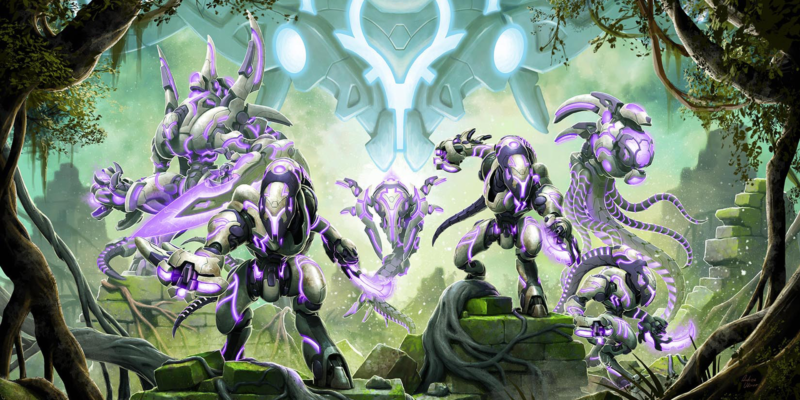
Of the organizational bodies of the empire, the Paladin forces are second only to the Ministries of the Alliance in sheer scale. Though the Ministries, which directly employ over 4 percent of the population of the empire, dwarfs the number of soldiers directly serving the ISA, an even greater number work in support of the Paladin forces when considering the requirements of war production and industry.
As has been described in the previous section, the Paladins are a formidable, well-trained, and well-equipped professional fighting force. On the tabletop, Paladin models have the standardized stat line of professional human soldiers. And though their ARM value of 3 is the same as the Marcher Worlds’ Ranger forces, the fully encased Paladin compound armor also conveys an additional +1 ARM against explosion damage, offering the Alliance soldiers some additional protection beyond that enjoyed by their rivals. The armor itself also integrates a single Arc receiver and is fitted over a plexus, a durable mesh body suit used to maintain and regulate the flow of arcane energies bestowed on a squad in the form of friendly Cyphers.
Additionally, Paladin forces are equipped with the some of the most advanced mechanikal equipment and weaponry available to the human powers. These soldiers have been trained to act in concert with Warcasters and the warjacks that fight alongside them. Typically, Paladins tasked to serve as part of a Warcaster battlegroup do so in small numbers, limited to the forces a Warcaster can support in battle.
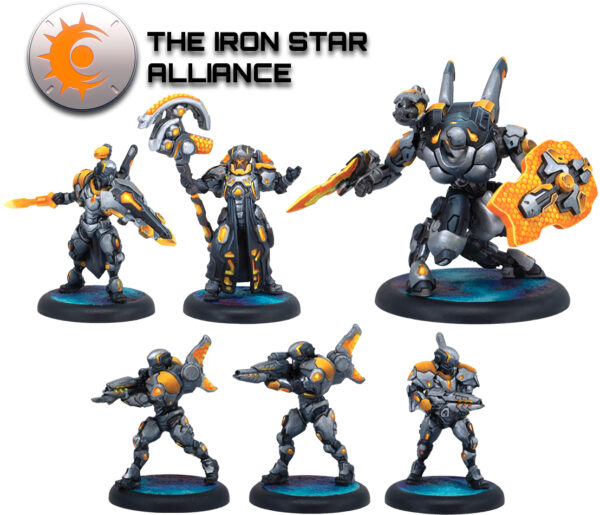
The Paladins also operate in formations far larger than those that can be supported by a single Warcaster. In such cases, the Paladin forces will either be divided into smaller task forces, each attached to a different Warcaster, or they will be supported by Arc Masts, powerful mechanika generators that charge an area with ambient arcane energy. Arc Masts can keep the Alliance’s mechanika weapons and equipment charged, even in the absence of a Warcaster.
Of the three different service branches of the Paladins we have revealed so far—the Annihilators, the Defenders, and the Enforcers—each has its own well-defined role, capabilities, and armament.
The Annihilators are the Paladins’ heavy weapon support squads. While relatively slow moving due to the bulk and weight of their Harbinger Cannons (reducing their SPD to 4 rather than the Paladin standard SPD of 6), the Annihilators more than make up for this shortcoming with the effectiveness of their ranged attacks. The Harbinger Cannon is a strafe weapon equipped with a potent mechanikal guidance system. While the squad is charged, the Annihilators can maintain a smart lock on their targets, allowing them to ignore cover when making their ranged attacks.
The Annihilators’ truly cutting-edge mechanika, however, is the Hunter-Killer ammunition fired from their cannons. The squad can spike to further empower their arcane guidance systems, enabling these projectiles to steer around walls and other obstacles to hit targets even without line of sight on them. I personally tend to use this capability as a method of freeing up Arc from an Annihilator squad by spiking on the squad’s last attack (if I don’t otherwise need to ignore line of sight). Waiting to spike until the last attack means the squad’s first two attacks will still gain a Power Die on the attack rolls because the squad will still be charged when the attacks are made.
Equipped with spear and shield, the Defenders are the close-combat specialists of the Paladin forces. These hardy soldiers are not only better protected than the other Paladin soldiers (ARM 4 instead of the Annihilators’ and Enforcers’ ARM 3) but also have more threat range. Their Fusion Spears have a RNG of 2 that is increased to RNG 3 while the squad is charged. The potent weapons are POW 5, the highest among the weaponry of the Paladin forces. As implied by its name, the Defenders have an additional unique capability, the Intercept Driver. This piece of mechanika enables a model in the squad to spike to be hit by an attack meant for another friendly model. While more difficult to use for the purpose of clearing Arc from the squad, the Intercept Driver can be used to protect vulnerable solos or to sacrifice less well-positioned models in the squad in order to keep hold on an objective. Between their relatively high ARM and the raw POW of their melee attacks, the Defenders are ideally suited to taking and holding objectives. They may not be the first models I deploy in a game, but once I’ve made my way up the field, I will stuff as many down my opponent’s throat as I am able.
The Enforcers are the standard infantry of the Paladin forces. They are armed with assault rifles with bayonets. Their armor features reflex-accelerating mechanika that enables them to use both weapons in a single activation while charged, making them formidable opponents, both in close combat and at range. The Enforcers’ battle rifles are also equipped with Divination Lock targeting systems that allow the squad to spike to ignore Stealth and cover. As with the Annihilators’ Hunter-Killer ammunition, the Divination Lock can provide another excellent opportunity to clear Arc from this squad.
The Paladins are further reinforced and supported by Paladin Commanders, the Paladin Aegis, and the Paladin Siegebreakers.
Paladin Commanders represent the officer corps of the Paladin forces. These solos are well-trained combatants who are conditioned to lead troops in battle. They are additionally equipped with a sophisticated mechanika command interface system. The interface lets them maintain contact with both the Warcaster they serve and the soldiers they command. The Commander can also use the interface to spike to remove an activation token from a Paladin squad, freeing it up for further action. The Paladin Commander is also equipped with a reflex accelerator, like the Enforcers, enabling it to make both melee and ranged attacks while charged.

The Paladin Aegis a true support piece, an attachment that can be added to any Paladin squad. The Aegis troopers carry force generators that protect the models in their squads by giving them cover while charged. The power of the generator can also be directed outward as a potent force attack. The weapon locks down targets on a hit and can slam them if the Aegis spikes. The Paladin Aegis typifies the Alliance’s reliance upon and capacity to mass-produce complex mechanika.
Though among the best-trained and equipped forces in the Hyperuranion, even the Paladins have their limitations, especially when they are not supported by a dedicated Warcaster and a force of warjacks. Armed and armored to the teeth, the Paladin Siegebreaker exists to reinforce the Paladin forces. Fully encased in massive exo-armor, the Siegebreaker strides into battle like a living warjack. Though the solo packs an impressive array of weaponry, its true strength lies in its sustainability. With an ARM of 4 and 3 damage boxes, shooting a Siegebreaker off the table requires a real commitment of resources. In terms of their Deployment Cost, these models provide an inexpensive anchor for your Paladin forces to rally around.
With three squads to choose from and ample support models, the Paladins feel like a well-rounded fighting force even before we get into the Alliance’s warjack and vehicle options. That said, there is one glaring absence in their ranks: the Alliance does not make much use of field surgery or repairs. Aside from deploying the odd repair drone, the Alliance prefers to withdraw its damaged or injured assets for treatment off the battlefield. While the resource-strapped Marchers and Continuum forces may be required to patch up their beleaguered forces in the field, the Alliance prefers to simply recall them and replace them with fresh forces from their reserves.
The Alliance’s commitment to expansion has forever slaved its industry to the empire’s war effort. The demands of the bloc’s military consume an incredible range of resources while at the same time ensure near-universal employment throughout Alliance space. The vast tangle of supply and production concerns are overseen by the Ministry of War, which is dedicated to the development, manufacture, and transport of mechanika, arms, warjacks, and fighting vessels. The Ministry not only commands the constant flow of weapons and equipment but also oversees all aspects of war production and fulfillment.
Unlike the military forces of their rivals, the Alliance does not depend on jury-rigged or repurposed civilian or industrial tools to serve as weapons of war. Instead, every piece of military hardware is painstakingly developed and rigorously tested through a process of iterative design. Parts are manufactured and assembled at vast factory complexes dedicated to wartime production. As a result, even warjacks and combat vehicles can be rapidly produced in great numbers to the Alliance’s exacting standards.
Due to both the requirements of mass production and the fact that the Alliance would rather replace damaged warjacks than repair them in the field, their machines tend to be somewhat less durable and ruggedly made than the overly engineered and heavily armored warjacks of their rivals. Long ago, the Alliance determined that more lightly armed warjacks can be produced more quickly and cheaply than more heavily armored machines. The functional disparity could be offset by arming the warjack with a shield that could also serve as a close combat weapon. This is the reason that Alliance warjacks have a similar stat line as the warjacks of their rivals, but their ARM stats tend to be somewhat lower. Certainly you can choose to forego the shield options for more offensive weaponry, but you will be likely deploying fresh warjacks to the battlefield more often as a result.
The Alliance’s two workhorse warjacks are the Firebrand and the Morningstar. Though the Alliance has a number of warjack designs in their arsenal to fulfill a variety of combat roles, none offer the tactical flexibility of these two mainstays.
The Firebrand, the lighter of the two, features a Force Projector and Refractor Field. The Force Projector increases the RNG of the warjack’s melee weapons by 1 when it is charged. While this may pigeonhole the Firebrand into a melee support role, it has enough solid weapon options to either lean into this capacity and shine or eschew it completely for its compelling ranged options. The Refractor Field was intended to make up for the warjack’s low ARM (3) by enabling it to spike to reroll its defense role. The thinking here is that if you can’t land a blow, what difference does the warjack’s ARM make?
The Morningstar is a more dedicated ranged weapon platform. It is heavier than the Firebrand, with one higher STR and ARM and one additional damage box. The Morningstar also has 8 Weapon Points instead of the Firebrand’s 5, divided between 4 Hard Points as compared to the Firebrand’s 3. The real differences, however, are in the mechanika. The Morningstar’s Range Amplifier increases the RNG of its ranged weapons by +1 for each Arc the warjack is charged with. When the warjack is targeted and hit by an enemy attack, its Impulse Reciprocator enables it to spike to immediately make an attack of its own, thus testing the old adage that the best defense is a good offense.
It is noteworthy that neither of these warjacks possesses proactive means of spiking to clear Arc. If you prefer to keep your Arc flowing from turn to turn like I do, you may want to carefully consider your warjacks weapon options when you are building your force to make sure you have some ability to free up Arc from your ’jacks without waiting for your opponent to target them in combat.
Finally, there is the screaming-fast Interceptor. With a SPD of 9 and the ability to move up to 3˝ any time it is missed by an attack while charged, nothing aside from the Aeternus Continuum’s Nemesis warjack comes close to it. A true precision instrument, the Interceptor can spike to play two Maneuvers each activation, proving it is truly in a class all its own.
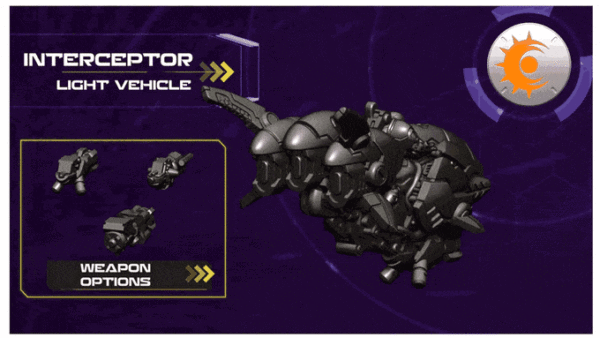
Though the Alliance puts nearly as much effort into testing and developing its Cyphers as it does its other military assets, its knowledge of the arcane trails its rivals, especially the Empyreans and the Aeternus Continuum. Even if the Alliance shared the Empyreans’ ancient mastery of the arcane or the Continuum’s utter and single-minded dedication to its pursuit, the bloc’s conservative tactics and methodologies would make integrating such knowledge difficult. It is the nature of the Alliance to measure, debate, and quantify every tool and weapon at its disposal. In the Alliance, creativity and ingenuity regularly take a backseat to stability and reliability, even in the application of practical magic.
The Cyphers of the Alliance are rotes of combat. They are delivered by Weavers, who are trained to serve alongside the Paladins. Paladin Weavers can be found amongst any task force operating under a Warcaster. Even more so than the Alliance’s officer corps, the Weavers are trained to act in perfect concert with the Warcaster, to intuitively perceive the actions of the Warcaster and their own place on the battlefield to most easily operate as a vector for the Warcaster’s powerful arcane attacks. In addition to the Weaver’s talents as a channeler, the arcanist’s most unique capability comes from its Realignment Codex, a piece of mechanika that enables the Weaver to spike to charge a friendly unit or to clear Arc from it. This ability not only frees up Arc from this model, but it can simultaneously fill a warjack up to its Arc capacity as well.
The Alliance’s military assets are rounded out with their solo Hero options, Justicar Voss and the three Wild Cards willing to seek employment with the empire.
Significantly outranking even the Warcasters he fights alongside, Justicar Voss is among the most powerful individuals in the whole of the Alliance. And in addition to his authority granted by the empire, Voss is also a singularly deadly melee combatant. Not only is each of his paired swords POW 5, but Voss also has a menu of special rules to choose from with every attack. What will drive your opponent to froth with rage, however, are his defensive capabilities. While charged, Voss gains +1 ARM, and when he is hit by an attack while charged, after the attack is resolved, you can reposition him anywhere within 2˝ of its current location. Finally, when Voss is hit by an enemy attack, before the damage roll is made, you can spike to have him ignore the effects of the attack completely before repositioning him anywhere within 8˝ of his current location.

When you play with Voss, get Arc on him as quickly as possible, and only remove it when your opponent forces your hand by targeting the Justicar. If it is nearly impossible to destroy Voss while he is charged, he will feel incredibly vulnerable any time he is not.
The Alliance’s Wild Card options include Baron Cassius Mooregrave, Doctor Myra Hurst, and Voitek Sudal, Bounty Hunter. While all three offer some unique capabilities to the Alliance, Doctor Hurst may be the standout because she enlarges your Cypher hand size from five to six, a potent force multiplier on the tabletop. That leaves just Mooregrave and Sudal. While Sudal can passively hinder your opponent’s midgame deployments with his Gate Jammer and can strip plenty of Arc from your opponent’s models with his Null Detonators, he lacks the offensive punch of Mooregrave. That said, Mooregrave is a melee specialist, and his role is slightly redundant with that of Voss, which is something to consider unless you are planning to get in close and go right for the jugular.

